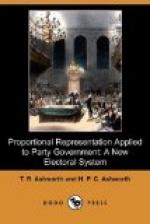Consider now the case of a voluntary association of individuals, such as a club or society; and suppose that it is required to elect a president or committee. The condition is clearly that he or they should be most in general favour with all the members; and the question whether Preferential Voting is applicable will depend on how united the members are. Now, clubs are not usually, nor should they be, divided into cliques or parties; indeed, if a serious split does take place it generally results in the resignation of part of the club and the formation of a separate organization. But in a live club it is impossible to prevent slight differences of opinion; and an officer-bearer who has the interests of the club at heart must often offend small sections who want to exert undue influence. In an election for president this office-bearer would stand no chance of election if there are several candidates and any small section likes to put him at the bottom of the list, so as to give him as many bad marks as possible. This is the weak point in Preferential Voting; any small section can ensure the rejection of a general favourite. The greater the number of candidates the smaller the minority which is able to do this; dummy candidates may therefore be introduced to make it more certain. The risk would, however, be very much lessened if the process of gradual elimination we have described were adopted.
When we come to the election of representatives to a legislature it is evident at once that Preferential Voting is not applicable at all. We have shown that the true condition required is not the return of candidates most in general favour with both parties, but the return of the candidates most in general favour with each party separately. Preferential Voting would therefore only be applicable if the electors of each party voted separately for its own candidates; and even then it would be open to the objection we have already urged. If it were applied to the two parties voting together the electors would certainly not be influenced only by the merit of the candidates. They might record their honest preferences as regards the candidates of their own party, but they would naturally place the candidates of the opposing party in inverse order of merit. The candidates most in general favour would be those who represented neither party. Suppose there are three candidates for a single seat, two representing large parties of 49 per cent, each, and the third a small party of 2 per cent. The electors of the large parties would be more afraid of one another than of the small party, and would give their second preferences to its candidate. This candidate, representing one-fiftieth of the electors, would then actually be elected; he would receive 202 marks, and neither of the others could possibly secure more than 200. Moreover, he would still be elected if the process of elimination were adopted, since on the second count he would beat either of the other candidates separately by 51 votes to 49.




